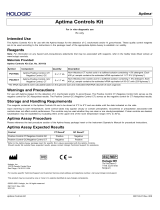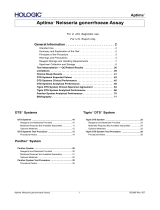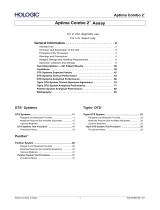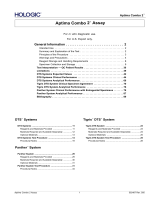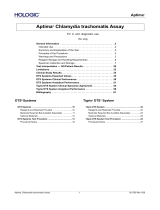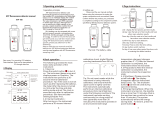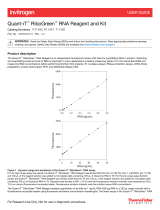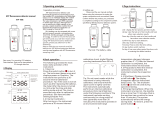Page is loading ...

Aptima® Trichomonas vaginalis Assay (Panther® System)
Aptima®
Aptima Trichomonas vaginalis Assay 1 503797 Rev. 004
For in vitro diagnostic use.
For U.S. Export only.
General Information . . . . . . . . . . . . . . . . . . . . . . . . . . . . . . . . . . . . . . . . . . . . . . . . . .2
Intended Use . . . . . . . . . . . . . . . . . . . . . . . . . . . . . . . . . . . . . . . . . . . . . . . . . . . . .2
Summary and Explanation of the Test . . . . . . . . . . . . . . . . . . . . . . . . . . . . . . . . . .2
Principles of the Procedure . . . . . . . . . . . . . . . . . . . . . . . . . . . . . . . . . . . . . . . . . .2
Warnings and Precautions . . . . . . . . . . . . . . . . . . . . . . . . . . . . . . . . . . . . . . . . . . .3
Reagent Storage and Handling Requirements . . . . . . . . . . . . . . . . . . . . . . . . . . . .5
Specimen Collection and Storage . . . . . . . . . . . . . . . . . . . . . . . . . . . . . . . . . . . . .6
Panther System . . . . . . . . . . . . . . . . . . . . . . . . . . . . . . . . . . . . . . . . . . . . . . . . . . . . .8
Reagents and Materials Provided . . . . . . . . . . . . . . . . . . . . . . . . . . . . . . . . . . . . .8
Materials Required But Available Separately . . . . . . . . . . . . . . . . . . . . . . . . . . . . .9
Optional Materials . . . . . . . . . . . . . . . . . . . . . . . . . . . . . . . . . . . . . . . . . . . . . . . . .10
Panther System Test Procedure . . . . . . . . . . . . . . . . . . . . . . . . . . . . . . . . . . . . . .11
Procedural Notes . . . . . . . . . . . . . . . . . . . . . . . . . . . . . . . . . . . . . . . . . . . . . . . . .13
Test Interpretation — QC/Patient Results . . . . . . . . . . . . . . . . . . . . . . . . . . . . . . .15
Limitations . . . . . . . . . . . . . . . . . . . . . . . . . . . . . . . . . . . . . . . . . . . . . . . . . . . . . . . .16
Expected Values . . . . . . . . . . . . . . . . . . . . . . . . . . . . . . . . . . . . . . . . . . . . . . . . . . . .18
Prevalence . . . . . . . . . . . . . . . . . . . . . . . . . . . . . . . . . . . . . . . . . . . . . . . . . . . . . .18
Positive and Negative Predictive Values for Hypothetical Prevalence Rates . . . .18
Panther System Clinical Performance . . . . . . . . . . . . . . . . . . . . . . . . . . . . . . . . . .20
Clinical Study . . . . . . . . . . . . . . . . . . . . . . . . . . . . . . . . . . . . . . . . . . . . . . . . . . . .20
RLU Distribution of Aptima Trichomonas vaginalis Controls . . . . . . . . . . . . . . . .23
Reproducibility Study . . . . . . . . . . . . . . . . . . . . . . . . . . . . . . . . . . . . . . . . . . . . . .24
Panther System Analytical Performance . . . . . . . . . . . . . . . . . . . . . . . . . . . . . . . .25
Analytical Sensitivity . . . . . . . . . . . . . . . . . . . . . . . . . . . . . . . . . . . . . . . . . . . . . . .25
Cross-Reactivity in the Presence of Microorganisms . . . . . . . . . . . . . . . . . . . . . .25
Interference . . . . . . . . . . . . . . . . . . . . . . . . . . . . . . . . . . . . . . . . . . . . . . . . . . . . .26
Carryover . . . . . . . . . . . . . . . . . . . . . . . . . . . . . . . . . . . . . . . . . . . . . . . . . . . . . . .26
Specimen Stability . . . . . . . . . . . . . . . . . . . . . . . . . . . . . . . . . . . . . . . . . . . . . . . . . .27
Bibliography . . . . . . . . . . . . . . . . . . . . . . . . . . . . . . . . . . . . . . . . . . . . . . . . . . . . . . .27

Aptima Trichomonas vaginalis Assay 2 503797 Rev. 004
General Information Aptima®
General Information
Intended Use
The Aptima® Trichomonas vaginalis Assay is an in vitro qualitative nucleic acid amplification test
(NAAT) for the detection of ribosomal RNA (rRNA) from Trichomonas vaginalis to aid in the
diagnosis of trichomoniasis using the Panther® System.
The assay may be used to test the following specimens from symptomatic or asymptomatic
women: clinician-collected endocervical swabs, clinician-collected vaginal swabs, female urine
specimens, and specimens collected in PreservCyt Solution.
Summary and Explanation of the Test
Trichomonas vaginalis (TV) is the most common curable sexually transmitted disease (STD)
agent in the United States, with an estimated 7.4 million new cases occurring annually (1, 2).
Infections in women cause vaginitis, urethritis, and cervicitis. Discharge and small hemorrhagic
lesions may be present in the genitourinary tract. Complications can include premature labor,
low-birth-weight offspring, premature rupture of membranes, and post-abortion or post-
hysterectomy infection. An association with pelvic inflammatory disease, tubal infertility, and
cervical cancer with previous episodes of trichomoniasis has been reported. Symptomatic
women with trichomoniasis usually complain of vaginal discharge, vulvovaginal soreness, and/or
irritation. Dysuria is also common. However, it has been estimated that 10 to 50% of T. vaginalis
infections in women are asymptomatic, and in men the proportion may even be higher (3, 4, 5).
Detection of T. vaginalis with traditional culture methods is technically challenging and requires
up to 7 days. Immediate inoculation into the media is preferred, and proper incubation conditions
are required in addition to frequent microscopic examinations of the media to successfully culture
the protozoa. The sensitivity of culture has been estimated to range from 38% to 82% when
compared to molecular methods due to problems visualizing low numbers of the organisms or
the motility of the protozoa (6, 7).
T. vaginalis may also be detected using “wet-mount” preparation by mixing vaginal secretions
with saline on a slide and examining the slide under a microscope. However, the wet-mount
method is only 35% to 80% sensitive compared with culture (7). The sensitivity of the wet-mount
method is highly dependent on the experience of the microscopist as well as the time of
specimen transport to the laboratory.
The Aptima Trichomonas vaginalis Assay is a nucleic acid test that utilizes Target Capture,
Transcription-Mediated Amplification (TMA), and Hybridization Protection Assay (HPA)
technologies.
Principles of the Procedure
The Aptima Trichomonas vaginalis Assay involves the technologies of target capture,
transcription-mediated amplification (TMA), and hybridization protection assay (HPA).
Specimens are collected and transferred into their respective specimen transport tubes. The
transport solution in these tubes releases the rRNA target and protects it from degradation
during storage. When the Aptima Trichomonas vaginalis Assay is performed in the laboratory,
the target rRNA is isolated from the specimens by the use of a specific capture oligomer and

Aptima Trichomonas vaginalis Assay 3 503797 Rev. 004
Aptima®General Information
magnetic microparticles in a method called target capture. The capture oligomer contains a
sequence complementary to a specific region of the target molecule as well as a string of
deoxyadenosine residues. During the hybridization step, the sequence-specific region of the
capture oligomer binds to a specific region of the target molecule. The capture oligomer:target
complex is then captured out of solution by decreasing the temperature of the reaction to room
temperature. This temperature reduction allows hybridization to occur between the
deoxyadenosine region on the capture oligomer and the poly-deoxythymidine molecules that are
covalently attached to the magnetic particles. The microparticles, including the captured target
molecule bound to them, are pulled to the side of the reaction vessel using magnets and the
supernatant is aspirated. The particles are washed to remove residual specimen matrix that may
contain amplification inhibitors. After the target capture steps are completed, the specimens are
ready for amplification.
Target amplification assays are based on the ability of complementary oligonucleotide primers to
specifically anneal and allow enzymatic amplification of the target nucleic acid strands. The
Hologic™ TMA reaction amplifies a specific region of the small ribosomal subunit from T.
vaginalis via DNA and RNA intermediates and generates RNA amplicon molecules. Detection of
the rRNA amplification product sequences is achieved using nucleic acid hybridization (HPA). A
single-stranded chemiluminescent DNA probe, which is complementary to a region of the target
amplicon, is labeled with an acridinium ester molecule. The labeled DNA probe combines with
amplicon to form stable RNA:DNA hybrids. The Selection Reagent differentiates hybridized from
unhybridized probe, eliminating the generation of signal from unhybridized probe. During the
detection step, light emitted from the labeled RNA:DNA hybrids is measured as photon signals in
a luminometer and are reported as Relative Light Units (RLU).
Warnings and Precautions
A. For in vitro diagnostic use.
B. For additional specific warnings and precautions, refer to the Panther System Operator’s
Manual.
Laboratory Related
C. Use only supplied or specified disposable laboratory ware.
D. Use routine laboratory precautions. Do not eat, drink or smoke in designated work areas.
Wear disposable, powderless gloves, protective eye wear, and laboratory coats when
handling specimens and kit reagents. Wash hands thoroughly after handling specimens and
kit reagents.
E. Warning: Irritant and Corrosive. Avoid contact of Auto Detect 2 with skin, eyes and mucous
membranes. If this fluid comes into contact with skin or eyes, wash with water. If spills of this
fluid occur, dilute the spill with water before wiping dry.
F. Work surfaces, pipettes, and other equipment must be regularly decontaminated with 2.5% to
3.5% (0.35M to 0.5M) sodium hypochlorite solution.

Aptima Trichomonas vaginalis Assay 4 503797 Rev. 004
General Information Aptima®
Specimen Related
G. Expiration dates for the specimen transfer kits pertain to the collection/transfer of specimens
and not to specimen testing. Specimens collected/transferred any time prior to these
expiration dates are valid for testing provided they have been transported and stored in
accordance with the package insert, even if the expiration date on the transfer tube has
passed.
H. Specimens may be infectious. Use Universal Precautions when performing this assay. Proper
handling and disposal methods should be established by the laboratory director. Only
personnel adequately trained in handling infectious materials should be permitted to perform
this diagnostic procedure.
I. Avoid cross-contamination during the specimen handling steps. Specimens can contain
extremely high levels of organisms. Ensure that specimen containers do not contact one
another, and discard used materials without passing over any container. Change gloves if
they come in contact with specimen.
J. Upon piercing, liquid can discharge from Aptima transfer tube caps under certain conditions.
Refer to the appropriate Test Procedure for more information.
K. After urine has been added in the urine transport tube, the liquid level must fall between the
two black indicator lines on the tube label. Otherwise, the specimen must be rejected.
L. Maintain proper storage conditions during specimen shipping to ensure the integrity of the
specimen. Specimen stability under shipping conditions other than those recommended has
not been evaluated.
M. If the lab receives a swab specimen transport tube with no swab, two swabs, a cleaning
swab, or a swab not supplied by Hologic, the specimen must be rejected.
Assay Related
N. Store reagents at the specified temperatures. Performance of the assay may be affected by
use of improperly stored reagents.
O. Use Universal Precautions when handling controls.
P. Avoid microbial and ribonuclease contamination of reagents.
Q. Do not use kit after its expiration date.
R. Do not interchange, mix, or combine assay reagents from kits with different lot numbers.
Controls and assay fluids may be interchanged.

Aptima Trichomonas vaginalis Assay 5 503797 Rev. 004
Aptima®General Information
Reagent Storage and Handling Requirements
A. The following reagents are stable when stored at 2ºC to 8ºC:
Aptima
Trichomonas vaginalis
Amplification Reagent
Aptima
Trichomonas vaginalis
Enzyme Reagent
Aptima
Trichomonas vaginalis
Probe Reagent
Aptima
Trichomonas vaginalis
Assay Target Capture Reagent B
Aptima
Trichomonas vaginalis
Controls
B. The following reagents are stable when stored at room temperature (15°C to 30°C):
Aptima
Trichomonas vaginalis
Amplification Reconstitution Solution
Aptima
Trichomonas vaginalis
Enzyme Reconstitution Solution
Aptima
Trichomonas vaginalis
Probe Reconstitution Solution
Aptima
Trichomonas vaginalis
Target Capture Reagent
Aptima
Trichomonas vaginalis
Selection Reagent
C. After reconstitution, Amplification Reagent, Enzyme Reagent, and Probe Reagent are stable
for 60 days when stored at 2ºC to 8ºC.
D. Working Target Capture Reagent (wTCR) is stable for 60 days when stored at 15ºC to 30ºC.
Do not refrigerate.
E. Discard any unused reconstituted reagents and wTCR after 60 days, or after the Master Lot
expiration date, whichever comes first.
F. Controls are stable until the date indicated on the vials.
G. Reagents stored on-board the Panther System have 72 hours of on-board stability.
H. Avoid cross-contamination during reagent handling and storage. Recap all reconstituted
reagents with new reagent caps each time prior to storage.
I. The Probe Reagent and Reconstituted Probe Reagent are photosensitive. Store the reagents
protected from light.
J. Do not freeze reagents.

Aptima Trichomonas vaginalis Assay 6 503797 Rev. 004
General Information Aptima®
Specimen Collection and Storage
The Aptima Trichomonas vaginalis Assay is designed to detect the presence of T. vaginalis in
clinician-collected endocervical and vaginal swab specimens, female urine specimens, and
PreservCyt liquid Pap specimens. Performance with specimens other than those collected with
the following specimen collection kits has not been evaluated:
• Aptima Unisex Swab Specimen Collection Kit for Endocervical and Male Urethral Swab
Specimens
• Aptima Urine Collection Kit for Male and Female Urine Specimens
• Aptima Multitest Swab Specimen Collection Kit
• Aptima Specimen Transfer Kit (for use with gynecological samples collected in
PreservCyt Solution)
A. Instructions for collection
1. Refer to the appropriate specimen collection kit package insert for specific collection
instructions.
B. Specimen transport and storage before testing:
1. Swab specimens
a. After collection, transport and store the swab in the swab specimen transport tube at
2°C to 30°C until tested.
b. Assay specimens within 60 days of collection. If longer storage is needed, freeze the
specimen transport tube at ≤ –20°C for up to 24 months.
2. Urine specimens
a. Urine specimens that are still in the primary collection container must be transported
to the lab at 2°C to 30°C. Transfer the urine specimen into the Aptima urine specimen
transport tube within 24 hours of collection.
b. Store processed urine specimens at 2°C to 30°C and assay within 30 days after
transfer. If longer storage is needed, store the processed urine specimen at ≤ –20°C
for up to 24 months after transfer.
3. Specimens collected in PreservCyt Solution
a. Transport and store the PreservCyt Solution specimen at 2°C to 30°C for up to 30
days.
b. Specimens collected in PreservCyt Solution must be transferred into an Aptima
specimen transfer tube according to the instructions in the Aptima Specimen Transfer
kit package insert.
c. After transfer to an Aptima specimen transfer tube, specimens may be stored an
additional 14 days at 15°C to 30°C or 30 days at 2°C to 8°C.
d. If longer storage is needed, the PreservCyt Solution specimen or the PreservCyt
Solution liquid Pap specimen diluted into the specimen transfer tube may be stored at
≤ –20°C for up to 24 months after transfer.

Aptima Trichomonas vaginalis Assay 7 503797 Rev. 004
Aptima®General Information
C. Specimen storage after testing:
1. Specimens that have been assayed must be stored upright in a rack.
2. The specimen transport tubes should be covered with a new, clean plastic film or foil
barrier.
3. If assayed samples need to be frozen or shipped, remove penetrable cap and place new
non-penetrable caps on the specimen transport tubes. If specimens need to be shipped
for testing at another facility, recommended temperatures must be maintained. Prior to
uncapping, specimen transport tubes must be centrifuged for 5 minutes at 420 RCF
(Relative Centrifugal Force) to bring all of the liquid down to the bottom of the tube.
Avoid splashing and cross-contamination.
Note: Specimens must be shipped in accordance with applicable national and international
transportation regulations.

Aptima Trichomonas vaginalis Assay 8 503797 Rev. 004
Panther System Aptima®
Panther System
Reagents for the Aptima Trichomonas vaginalis Assay are listed below for the Panther System.
Reagent Identification Symbols are also listed next to the reagent name.
Reagents and Materials Provided
Note: For information on any hazard and precautionary statements that may be associated with
reagents, refer to the Safety Data Sheet Library at www.hologicsds.com.
Aptima Trichomonas vaginalis Assay (Panther System) Kit
250 tests (2 boxes and 1 Controls kit) (Cat. No. 303537)
100 tests (2 boxes and 1 Controls kit) (Cat. No. 303536)
Aptima Trichomonas vaginalis Assay Refrigerated Box (Box 1 of 2)
(store at 2°C to 8°C upon receipt)
Symbol Component
Quantity
250-test kit 100-test kit
A Aptima
Trichomonas vaginalis Amplification Reagent
Primers and nucleotides dried in buffered solution containing
< 5% bulking agent.
1 vial 1 vial
E Aptima Trichomonas vaginalis Enzyme Reagent
Reverse transcriptase and RNA polymerase dried in HEPES
buffered solution containing < 10% bulking reagent.
1 vial 1 vial
P Aptima Trichomonas vaginalis Probe Reagent
Chemiluminescent DNA probes dried in succinate buffered
solution containing < 5% detergent.
1 vial 1 vial
TCR-B Aptima Trichomonas vaginalis Assay Target Capture
Reagent B
Buffered solution containing < 5% detergent.
1 x 0.56 mL 1 x 0.30 mL
Aptima Trichomonas vaginalis Assay Room Temperature Box (Box 2 of 2)
(store at room temperature, 15°C to 30°C upon receipt)
Symbol Component
Quantity
250-test kit 100-test kit
AR Aptima Trichomonas vaginalis Amplification
Reconstitution Solution
Aqueous solution containing preservatives.
1 x 27.7 mL 1 x 11.9 mL
ER Aptima Trichomonas vaginalis Enzyme Reconstitution
Solution
HEPES buffered solution containing a surfactant and
glycerol.
1 x 11.1 mL 1 x 6.3 mL

Aptima Trichomonas vaginalis Assay 9 503797 Rev. 004
Aptima®Panther System
Materials Required But Available Separately
Note: Materials available from Hologic have catalog numbers listed, unless otherwise specified.
PR Aptima Trichomonas vaginalis Probe Reconstitution
Solution
Succinate buffered solution containing < 5% detergent.
1 x 35.4 mL 1 x 15.2 mL
S Aptima Trichomonas vaginalis Selection Reagent
600 mM borate buffered solution containing surfactant.
1 x 108 mL 1 x 43.0 mL
TCR Aptima Trichomonas vaginalis Target Capture Reagent
Buffered solution containing capture oligomers and magnetic
particles.
1 x 54.0 mL 1 x 26.0 mL
Reconstitution Collars 3 3
Master Lot Barcode Sheet 1 sheet 1 sheet
Aptima Trichomonas vaginalis Controls Kit
(store at 2°C to 8°C upon receipt)
Symbol Component Quantity
NC Aptima Trichomonas vaginalis Negative Control
Non-infectious non-target nucleic acid in a buffered solution containing < 5%
detergent.
5 x 1.7 mL
PC Aptima Trichomonas vaginalis Positive Control
Non-infectious Trichomonas vaginalis organisms in buffered solution
containing < 5% detergent.
5 x 1.7 mL
Cat. No.
Panther System 303095
Aptima Assay Fluids Kit
(Aptima Wash Solution, Aptima Buffer for Deactivation Fluid, and Aptima Oil
Reagent)
303014 (1000 tests)
Aptima Auto Detect Kit 303013 (1000 tests)
Multi-tube units (MTUs) 104772-02
Panther Waste Bag Kit 902731
Panther Waste Bin Cover 504405
Or Panther Run Kit
contains MTUs, waste bags, waste bin covers, assay fluids, and auto detects
303096 (5000 tests)
Tips, 1000 µL conductive, liquid sensing 10612513 (Tecan)
Aptima Specimen Transfer Kit
for use with specimens in PreservCyt Solution
301154C
Aptima Trichomonas vaginalis Assay Room Temperature Box (Box 2 of 2)
(store at room temperature, 15°C to 30°C upon receipt) (continued)

Aptima Trichomonas vaginalis Assay 10 503797 Rev. 004
Panther System Aptima®
Optional Materials
Aptima Specimen Transfer Kit — printable
for use with specimens in PreservCyt Solution
PRD-05110
Aptima Multitest Swab Specimen Collection Kit PRD-03546
Aptima Unisex Swab Specimen Collection Kit for Endocervical and
Male Urethral Swab Specimens
301041
Aptima Urine Specimen Collection Kit for Male and Female Urine
Specimens
301040
Aptima Urine Specimen Transport Tubes for Male and Female
Urine Specimens
105575
Bleach, 5% to 7% (0.7 M to 1.0 M) sodium hypochlorite solution —
Disposable gloves —
SysCheck calibration standard 301078
Aptima penetrable caps 105668
Replacement non-penetrable caps 103036A
Replacement Caps for the 250-test kits
Amplification and Probe reagent reconstitution solutions
CL0041 (100 caps)
Enzyme Reagent reconstitution solution 501616 (100 caps)
TCR and Selection reagent CL0040 (100 caps)
—
Replacement Caps for 100-test kits
Amplification, Enzyme, and Probe reagent reconstitution solutions
CL0041 (100 caps)
TCR and Selection reagent 501604 (100 caps)
—
Cat. No.
Aptima Trichomonas vaginalis Controls Kit 302807
Hologic Bleach Enhancer for Cleaning
for routine cleaning of surfaces and equipment
302101

Aptima Trichomonas vaginalis Assay 11 503797 Rev. 004
Aptima®Panther System
Panther System Test Procedure
Note: See the Panther System Operator’s Manual for additional Panther System procedural
information.
A. Work Area Preparation
1. Clean work surfaces where reagents and samples will be prepared. Wipe down work
surfaces with 2.5% to 3.5% (0.35 M to 0.5 M) sodium hypochlorite solution. Allow the
sodium hypochlorite solution to contact surfaces for at least 1 minute and then follow with
a water rinse. Do not allow the sodium hypochlorite solution to dry. Cover the bench
surface on which the reagents and samples will be prepared with clean, plastic-backed
absorbent laboratory bench covers.
B. Reagent Reconstitution/Preparation of a New Kit
Note: Reagent reconstitution should be performed prior to beginning any work on the
Panther System.
1. To reconstitute Amplification, Enzyme, and Probe Reagents, combine the bottles of
lyophilized reagent with the reconstitution solution. If refrigerated, allow the reconstitution
solutions to reach room temperature before use.
a. Pair each reconstitution solution with its lyophilized reagent. Ensure that the
reconstitution solution and reagent have matching label colors before attaching the
reconstitution collar.
b. Check the lot numbers on the Master Lot Barcode Sheet to ensure that the
appropriate reagents are paired.
c. Open the lyophilized reagent vial and firmly insert the notched end of the
reconstitution collar into the vial opening (Figure 1, Step 1).
d. Open the matching reconstitution solution bottle, and set the cap on a clean, covered
work surface.
e. While holding the reconstitution solution bottle on the bench, firmly insert the other
end of the reconstitution collar into the bottle opening (Figure 1, Step 2).
f. Slowly invert the assembled bottles. Allow the solution to drain from the bottle into the
glass vial (Figure 1, Step 3).
g. Gently swirl the solution in the bottle to mix. Avoid creating foam while swirling the
bottle (Figure 1, Step 4).
h. Wait for the lyophilized reagent to go into solution, then invert the assembled bottles
again, tilting at a 45° angle to minimize foaming (Figure 1, Step 5). Allow all of the
liquid to drain back into the plastic bottle.
i. Remove the reconstitution collar and glass vial (Figure 1, Step 6).
j. Recap the plastic bottle. Record operator initials and reconstitution date on the label
(Figure 1, Step 7).
k. Discard the reconstitution collar and glass vial (Figure 1, Step 8).
Warning: Avoid creating foam when reconstituting reagents. Foam compromises the level-
sensing in the Panther System.

Aptima Trichomonas vaginalis Assay 12 503797 Rev. 004
Panther System Aptima®
Figure 1. Panther System Reconstitution Process
2. Prepare Working Target Capture Reagent (wTCR)
a. Pair the appropriate bottles of TCR and TCR-B.
b. Check the reagent lot numbers on the Master Lot Barcode Sheet to make sure that
the appropriate reagents in the kit are paired.
c. Open the bottle of TCR, and set the cap on a clean, covered work surface.
d. Open the bottle of TCR-B and pour the entire contents into the bottle of TCR. Expect
a small amount of liquid to remain in the TCR-B bottle.
e. Cap the bottle of TCR and gently swirl the solution to mix the contents. Avoid creating
foam during this step.
f. Record operator initials and the current date on the label.
g. Discard the TCR-B bottle and cap.
3. Prepare Selection Reagent
a. Check the lot number on the reagent bottle to make sure that it matches the lot
number on the Master Lot Barcode Sheet.
b. Record operator initials and the current date on the label.
Note: Thoroughly mix by gently inverting all reagents prior to loading on the system. Avoid
creating foam during inversion of reagents.
C. Reagent Preparation for Previously Reconstituted Reagents
1. Previously reconstituted Amplification, Enzyme, and Probe Reagents must reach room
temperature (15°C to 30°C) prior to the start of the assay.
2. If reconstituted Probe Reagent contains precipitate that does not return to solution at
room temperature, heat the capped bottle at a temperature that does not exceed 62°C for
1 to 2 minutes. After this heat step, the Probe Reagent may be used even if residual
precipitate remains. Mix Probe Reagent by inversion, being careful not to induce foam,
prior to loading onto the system.
3. Thoroughly mix each reagent by gently inverting prior to loading on the system. Avoid
creating foam during inversion of reagents.
4. Do not top off reagent bottles. The Panther System will recognize and reject bottles that
have been topped off.

Aptima Trichomonas vaginalis Assay 13 503797 Rev. 004
Aptima®Panther System
D. Specimen Handling
1. Allow the controls and specimens to reach room temperature prior to processing.
2. Do not vortex specimens.
3. Visually confirm that each specimen tube meets one of the following criteria:
a. The presence of a single blue Aptima collection swab in a unisex swab specimen
transport tube.
b. The presence of a single pink Aptima collection swab in a multitest or vaginal swab
specimen transport tube.
c. A final volume of urine between the black fill lines of a urine specimen transport tube.
d. The absence of a swab in the Aptima specimen transport tube for PreservCyt
Solution liquid Pap specimens.
4. Inspect specimen tubes before loading into rack:
a. If a specimen tube contains bubbles in the space between the liquid and the cap,
centrifuge the tube for 5 minutes at 420 RCF to eliminate the bubbles.
b. If a specimen tube has a lower volume than typically observed when collection
instructions have been followed, centrifuge the tube for 5 minutes at 420 RCF to
ensure that no liquid is in the cap.
c. If the liquid level in a urine specimen tube is not between the two black indicator lines
on the label, the specimen must be rejected. Do not pierce an overfilled tube.
d. If a urine specimen tube contains precipitate, heat the specimen at 37°C for up to 5
minutes. If the precipitate does not go back into solution, visually ensure that the
precipitate does not prevent delivery of the specimen.
Note: Failure to follow Steps 4a-4c may result in liquid discharge from the specimen tube
cap.
Note: Up to 4 separate aliquots can be tested from each specimen tube. Attempts to pipette
more than 4 aliquots from the specimen tube can lead to processing errors.
E. System Preparation
1. Set up the system according to the instructions in the Panther System Operator’s Manual
and Procedural Notes.
2. Load samples.
Procedural Notes
A. Controls
1. To work properly with the Panther Aptima Assay software, one pair of controls is required.
The Aptima Positive Control for Trichomonas and Aptima Negative Control for
Trichomonas can be loaded in any rack position or in any Sample Bay Lane on the
Panther System. Patient specimen pipetting will begin when one of the following two
conditions has been met:
a. A pair of controls is currently being processed by the system.
b. Valid results for the controls are registered on the system.

Aptima Trichomonas vaginalis Assay 14 503797 Rev. 004
Panther System Aptima®
2. Once the control tubes have been pipetted and are processing for a specific reagent kit,
patient specimens can be run with the associated kit up to 24 hours unless:
a. Controls results are invalid.
b. The associated assay reagent kit is removed from the system.
c. The associated assay reagent kit has exceeded stability limits.
3. Each Aptima control tube can be tested once. Attempts to pipette more than once from
the tube can lead to processing errors.
B. Temperature
Room temperature is defined as 15°C to 30°C.
C. Glove Powder
As in any reagent system, excess powder on some gloves may cause contamination of opened
tubes. Powderless gloves are recommended.
D. Lab Contamination Monitoring Protocol for the Panther System
There are many laboratory-specific factors that may contribute to contamination, including testing
volume, workflow, disease prevalence and various other laboratory activities. These factors should
be taken into consideration when contamination monitoring frequency is being established.
Intervals for contamination monitoring should be established based on each laboratory’s practices
and procedures.
To monitor for laboratory contamination, the following procedure may be performed using the
Aptima Unisex Swab Specimen Collection Kit for Endocervical and Male Urethral Swab
Specimens:
1. Label swab transport tubes with numbers corresponding to the areas to be tested.
2. Remove the specimen collection swab (blue shaft swab with green printing) from its
packaging, wet the swab in the swab transport medium, and swab the designated area
using a circular motion.
3. Immediately insert the swab into transport tube.
4. Carefully break the swab shaft at the score line; use care to avoid splashing of the
contents.
5. Recap the swab transport tube tightly.
6. Repeat Steps 2 to 5 for each area to be swabbed.
7. Test samples with the Aptima Trichomonas vaginalis Assay on the Panther System.
8. Further investigation should be performed if any samples yield a positive result.
If the results are positive, see
Test Interpretation — QC/Patient Results
. For additional Panther
System-specific contamination monitoring information, contact Hologic Technical Support.

Aptima Trichomonas vaginalis Assay 15 503797 Rev. 004
Aptima®Test Interpretation — QC/Patient Results
Test Interpretation — QC/Patient Results
A. Test Interpretation
Assay test results are automatically interpreted by the Panther System Aptima Trichomonas Assay
software. A test result may be negative, positive, or invalid as determined by total RLU in the
detection step (see below). A test result may be invalid due to RLU values outside the normal
expected ranges. Initial invalid test results should be retested. Report the first valid result.
B. Quality Control Results and Acceptability
The Aptima Negative Control for Trichomonas, which is labeled “NC CONTROL – TRICH,” and the
Aptima Positive Control for Trichomonas, which is labeled “PC CONTROL + TRICH,” act as
controls for the target capture, amplification, and detection steps of the assay. In accordance with
guidelines or requirements of national, regional, and/or local regulations or accrediting
organizations, additional controls for cell lysis and RNA stabilization may be included. The Aptima
Positive Control for Trichomonas which is labeled “PC CONTROL
+ TRICH” contains non-
infectious
T. vaginalis
rRNA.
The Aptima Trichomonas vaginalis Controls must produce the following test results:
Each laboratory should implement appropriate control procedures to satisfy the requirements of
CLIA regulations (section 493.1256).
Note: For assistance with out-of-range controls, contact Hologic Technical Support.
Test Interpretation Total RLU (x1000)
Negative 0* to < 100
Positive 100 to < 2400
Invalid 0* or ≥ 2400
*If the RLU measured on the Panther System is between 0 and 999, a
result of “0” is reported in the “Total RLU (000s)” column in the run
report. Measured RLU values less than 690 are reported as invalid.
RLU values between 690 and 999 are reported as valid.
Control Total RLU (x1000) T. vaginalis Result
NC Control – TRICH 0* and < 20 Negative
PC Control + TRICH ≥ 500 and < 2400 Positive
*If the RLU measured on the Panther System is between 0 and 999, a result of “0” is
reported in the “Total RLU (000s)” column in the run report. Measured RLU values less than
690 are reported as invalid. RLU values between 690 and 999 are reported as valid.

Aptima Trichomonas vaginalis Assay 16 503797 Rev. 004
Limitations Aptima®
Limitations
A. Use of this assay is limited to personnel who have been trained in the procedure. Failure to
follow the instructions given in this insert may result in erroneous results.
B. The effects of tampon use, douching, and specimen collection variables have not been
assessed for their impact on the detection of Trichomonas vaginalis.
C. TV-positive mucoid samples may exhibit decreased RLU values. To ensure proper
endocervical sampling, excess mucus should be removed.
D. Urine, vaginal swab and PreservCyt Solution liquid Pap specimen sampling is not designed
to replace cervical exams and endocervical specimens for diagnosis of female urogenital
infections. Patients may have cervicitis, urethritis, urinary tract infections, or vaginal infections
due to other causes or concurrent infections with other agents.
E. This assay has been tested using only the specimen types indicated. Performance with other
specimen types has not been evaluated.
F. Reliable results are dependent on adequate specimen collection. Because the transport
system used for this assay does not permit microscopic assessment of specimen adequacy,
training of clinicians in proper specimen collection techniques is necessary. See Specimen
Collection and Storage for instructions. For detailed information, refer to the appropriate
instructions for use.
G. Therapeutic failure or success cannot be determined with the Aptima Trichomonas vaginalis
Assay since nucleic acid may persist following appropriate antimicrobial therapy.
H. Results from the Aptima Trichomonas vaginalis Assay should be interpreted in conjunction
with other clinical data available to the clinician.
I. A negative result does not preclude a possible infection because results are dependent on
adequate specimen collection. Test results may be affected by improper specimen collection,
technical error, specimen mix-up, or target levels below the assay limit of detection.
J. A negative result does not preclude a possible infection because the presence of
Trichomonas tenax or Pentatrichomonas hominis in a specimen may affect the ability to
detect T. vaginalis rRNA. See Cross-Reactivity in the Presence of Microorganisms for details.
K. The Aptima Trichomonas vaginalis Assay provides qualitative results. Therefore, a correlation
cannot be drawn between the magnitude of a positive assay signal and the number of
organisms in a specimen.
L. The Aptima Trichomonas vaginalis Assay has not been validated for use with vaginal swab
specimens collected by patients.
M. Performance of the vaginal swab specimen has not been evaluated in pregnant women.
N. Performance of urine, vaginal swab, and PreservCyt Solution liquid Pap specimens has not
been evaluated in women less than 14 years of age.

Aptima Trichomonas vaginalis Assay 17 503797 Rev. 004
Aptima®Limitations
O. The performance of gynecological specimens collected in the PreservCyt Solution vial and
processed with the ThinPrep 2000 System or the ThinPrep 3000 System has not been
evaluated with the Aptima Trichomonas vaginalis Assay.
P. The performance of the Panther System has not been determined at altitudes above 2000 m
(6561 feet).
Q. If a specimen has a small number of T. vaginalis organisms, uneven distribution of these
trichomonads may occur, which may affect the ability to detect T. vaginalis rRNA in the
collected material. If negative results from the specimen do not fit with the clinical impression,
a new specimen may be necessary.
R. Customers must independently validate an LIS transfer process.

Aptima Trichomonas vaginalis Assay 18 503797 Rev. 004
Expected Values Aptima®
Expected Values
Prevalence
Estimates of the prevalence of T. vaginalis in different populations depend on the sensitivity of
the test in detecting the infection and on patient risk factors such as age, lifestyle, and the
presence or absence of symptoms. A summary of the prevalence of T. vaginalis, by specimen
type, as determined by the Aptima Trichomonas vaginalis Assay during the Panther System
clinical study is shown in Table 1.
Positive and Negative Predictive Values for Hypothetical Prevalence Rates
The estimated positive predictive value (PPV) and negative predictive value (NPV) of the Aptima
Trichomonas vaginalis Assay across different hypothetical prevalence rates are shown for each
specimen type in Table 2. These calculations are based on the overall estimated sensitivity and
specificity for each specimen type in the Panther System clinical study.
Table 1: Prevalence of T. vaginalis as Determined by the Aptima Trichomonas vaginalis Assay by Specimen Type
and Collection Site
Specimen
Type
%
(# positive / # tested)
All Sites Site 1 Site 2 Site 3 Site 4 Site 5 Site 6 Site 7 Site 8 Site 9
Urine 9.8 (64/650) 15.1 (8/53) 3.6 (2/55) 15.4 (2/13) 18.6 (8/43) 0.7 (1/136) 13.2 (10/76) 7.6 (11/144) 13.4 (11/82) 22.9 (11/48)
CVS 11.8 (80/678) 17.0 (9/53) 7.7 (4/52) 16.7 (2/12) 19.5 (8/41) 0.7 (1/145) 16.0 (12/75) 12.0 (21/175) 15.0 (12/80) 24.4 (11/45)
ES 11.2 (80/713) 20.4 (11/54) 8.9 (5/56) 12.5 (2/16) 17.1 (7/41) 0.6 (1/162) 20.2 (18/89) 9.1 (15/164) 13.3 (11/83) 20.8 (10/48)
PCyt 11.0 (81/739) 18.3 (11/60) 7.9 (5/63) 17.6 (3/17) 18.6 (8/43) 0.6 (1/167) 19.8 (17/86) 9.5 (16/169) 10.5 (9/86) 22.9 (11/48)
CVS = clinician-collected vaginal swab, ES = endocervical swab, PCyt = PreservCyt Solution liquid Pap.

Aptima Trichomonas vaginalis Assay 19 503797 Rev. 004
Aptima®Expected Values
Table 2: Hypothetical PPV and NPV of the Aptima Trichomonas vaginalis Assay by Specimen Type
Specimen Type Prevalence (%) PPV (%) NPV (%)
Urine
1 52.2 99.9
2 68.8 99.9
5 85.0 99.7
10 92.3 99.3
15 95.0 98.9
20 96.4 98.4
25 97.3 97.9
CVS
1 35.4 100
2 52.6 100
5 74.1 100
10 85.8 100
15 90.6 100
20 93.1 100
25 94.8 100
ES
1 34.8 100
2 51.8 100
5 73.5 100
10 85.4 100
15 90.3 100
20 93.0 100
25 94.6 100
PCyt
1 52.4 100
2 69.0 100
5 85.2 100
10 92.4 100
15 95.1 100
20 96.5 100
25 97.3 100
CVS = clinician-collected vaginal swab, ES = endocervical swab, PCyt = PreservCyt Solution liquid Pap.
The PPV and NPV are derived for different hypothetical prevalence rates using the sensitivity and
specificity estimates from the clinical performance study. Sensitivity was 93.7% in urine specimens, and
100% in vaginal swab, endocervical swab, and PreservCyt Solution liquid Pap specimens. Specificity was
99.1% in urine specimens, 98.2% in vaginal swab specimens, 98.1% in endocervical swab specimens,
and 99.1% in PreservCyt Solution liquid Pap specimens.

Aptima Trichomonas vaginalis Assay 20 503797 Rev. 004
Panther System Clinical Performance Aptima®
Panther System Clinical Performance
Clinical Study
Clinical performance of the Aptima Trichomonas vaginalis Assay on the Panther System was
evaluated using leftover specimens collected from consenting subjects during a previous,
prospective, multicenter clinical study of the Aptima Trichomonas vaginalis Assay on the Tigris
DTS System. Symptomatic and asymptomatic women were enrolled from 9 US clinical sites,
including obstetrics and gynecology, family planning, and STD clinics. One first-catch urine, 3
vaginal swab, 1 endocervical swab, and 1 PreservCyt Solution liquid Pap specimens were
collected from each subject. All specimens were clinician-collected except urine specimens.
PreservCyt liquid Pap specimens were collected with a broom-type device or a spatula and
cytobrush. Two of the vaginal swab specimens were tested with a commercially available culture
system and wet mount microscopic examination to establish infected status. The remaining
specimens were prepared for Aptima Trichomonas vaginalis Assay testing in accordance with
the appropriate Aptima specimen collection kit package insert instructions.
Panther System testing with the Aptima Trichomonas vaginalis Assay was conducted at 3 sites
(2 external laboratories and Hologic) in accordance with package insert instructions.
Performance characteristics of the Aptima Trichomonas vaginalis Assay were estimated by
comparing results to a patient infected status algorithm. In the algorithm, the designation of a
subject as being infected or non-infected with T. vaginalis was based on results from vaginal
swab specimens tested by culture and/or wet mount microscopic examination. At least one of
the reference test results was required to be positive to establish an infected patient status. Both
reference tests were required to be negative to establish a non-infected patient status.
A total of 651 urine, 689 vaginal swab, 737 endocervical swab, and 740 PreservCyt Solution
liquid Pap specimens were tested with the Aptima Trichomonas vaginalis Assay on the Panther
System. Specimens with initial invalid results were retested. One (1) urine, 11 vaginal swab, 24
endocervical swab, and 1 PreservCyt Solution liquid Pap specimens had final invalid results due
to hardware or software errors; these specimens were excluded from the analyses.
Table 3 shows the sensitivity, specificity, PPV, and NPV of the Aptima Trichomonas vaginalis
Assay on the Panther System and the prevalence of T. vaginalis (based on the infected status)
in each specimen type by symptom status and overall. Subjects were classified as symptomatic
if symptoms were reported by the subject. Subjects were classified as asymptomatic if the
subject did not report symptoms. Prevalence was higher in symptomatic women.
/



